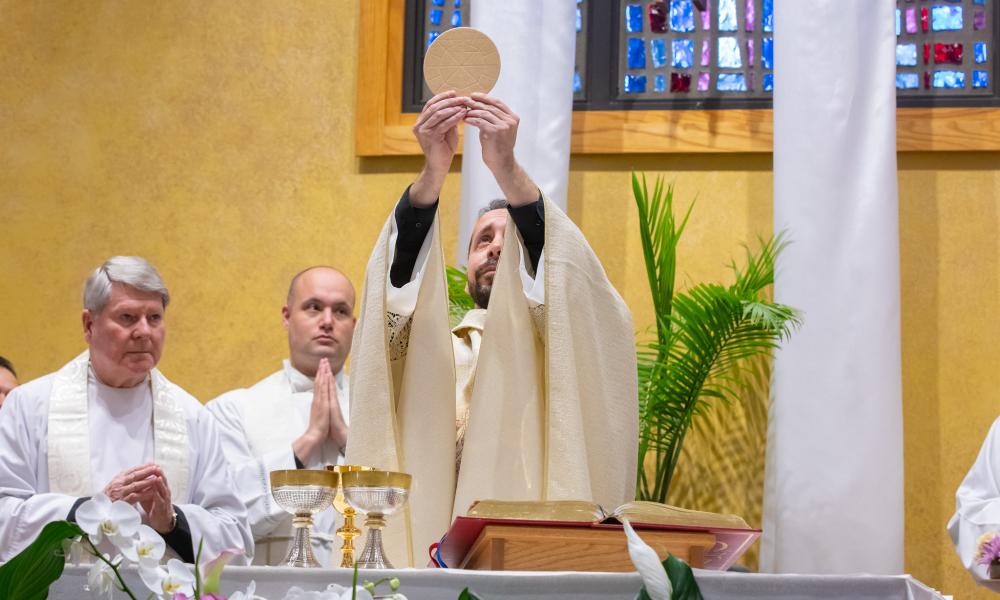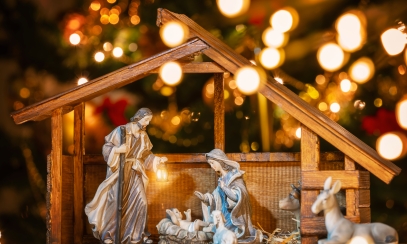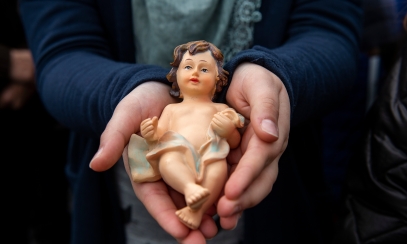
The Eucharist – Joining Ourselves to Christ
Christ is present at Mass in four ways.
Christ is present at Mass in four ways.
Caption: Father Donald Amodeo celebrated his first Mass as a priest at his home parish of St. Mary Catholic Church. He was ordained to the priesthood on May 21, 2022. Photo Credit: Steve and Kaia Poisall
Caption: Father Donald Amodeo celebrated his first Mass as a priest at his home parish of St. Mary Catholic Church. He was ordained to the priesthood on May 21, 2022. Photo Credit: Steve and Kaia Poisall
August 30, 2022 | On the night before he died, Christ gathered His disciples for a meal. He took simple bread and wine. He blessed it in a great prayer of thanksgiving to His Father. He broke the bread and gave it to His disciples. It was a familiar ritual, only this time it was different.
This bread “is my body which will be given up for you,” Christ said. This cup “is the cup of my blood, the blood of the new and everlasting covenant. It will be shed for you and for all so that sins may be forgiven.” He commanded that we continue to do this in memory of him (cf. 1 Cor. 23-26).
The Church has never failed to follow this command. We continue to celebrate this sacrament and to give thanks (Greek – eucharistein) to God. And we follow the same four-fold pattern of taking, blessing, breaking and giving.
The Lord’s Supper has always been inextricably linked to our Sunday assemblies. We do not recreate the Last Supper every Sunday morning, rather we engage in anamnesis – a memory that makes present. In the great Eucharistic Prayer, we join ourselves to the sacrifice of Christ, made present on our altar, and offered again to the Father. This is the source and summit of the Christian life (SC #10, CCC 1324).
Christ is present in four ways in the Mass – in the people, in the Word, in the priest and in the Eucharistic elements. In traditional theological language, Christ becomes present under the appearance of bread and wine. The ‘substance’ (deepest reality) of bread and wine are changed by the Holy Spirit to the ‘substance’ of Christ’s body and blood. The ‘accidents’ (appearance or physical attributes) of bread and wine remain. This is defined as ‘transubstantiation’ (CCC 1376).
Christ is wholly present in either the bread or the wine, but it is fitting to receive Christ under both forms as a fuller expression and foretaste of the heavenly banquet.
When we receive Communion, we hear those wonderfully ambiguous words – “The Body of Christ.” We respond “Amen” (so be it). In so doing, we express our faith in the true presence of Christ in the Eucharistic bread. But we also remind ourselves that this sacrament forms us into the Body of Christ. Nourished by this bread and wine, Christ’s body and blood, we are called by God, through Christ our Head, and by the grace of the Spirit, to build the kingdom of God on earth.
In this sacrament, we find the cause and sign of our unity. In this sacrament, especially, the Lord continues to dwell among His people.
Timeline: Major developments in understanding the Eucharist
30-33 AD Public Ministry of Jesus
Meals are important – the wedding feast at Cana, feeding of the 5,000, dining with sinners and tax collectors
Jesus institutes the Eucharist at the Last Supper and commands his disciples to “Do this in memory of Me.” (1 Cor 11:23-25, Mt 26: 26-29; Mk 14: 22-25; Lk 22: 14-20)
Post-Resurrection Meals
The disciples walk with Jesus on the road to Emmaus, but recognize him in the breaking of the bread (Lk 24:13-35). Christ prepares breakfast on the seashore (Jn 21:1-14).
New Testament
Eucharist as part of an agape meal. Paul scolds Corinth about its Eucharistic practices (1 Cor 11: 17 22, 26-34) and reminds them that “every time we eat this bread and drink this cup we proclaim the death of our Lord” (11: 26).
2nd to 8th Centuries
Ignatius of Antioch – Letter to the Philadelphians (110)
Three things as norm:
1) a gathered assembly
2) the presidency of bishop
3) the action of praise and thanksgiving with bread and wine
Justin Martyr (150) – First Apology
1) early Christians gathered on a Sunday
2) presiders gave thanks to the best of their ability
3) Eucharist taken to absent members
4) Eucharist as part of initiation rite
Tertullian (160-255) On Prayer
1) Communion on Sundays, Wednesdays and Fridays
2) penitential fasting and Eucharistic feasting are incompatible
Cyprian of Carthage
The Lapsed (251)
Repentance and reconciliation as conditions for Communion
9-10th Centuries
1) Latin is being used at Mass
2) Private prayers of the priest added to liturgy
3) Shift in understanding – priest praying while people doing other things
4) Priests begin to give Communion in mouth
5) Communion is distributed after Mass
6) gradual removal of cup from laity
9th Century Controversy
Radbertus teaches that Christ’s presence is real and literal – God multiplies Body of Christ, hosts will bleed; but Ratramnus teaches that the presence of Christ is real and sacramental – bread and wine are true signs of Christ
11-12th Centuries
1) great attitude change
2) Eucharist not something to eat and drink, but an object to be reverenced
3) Decline in reception of Communion – people don’t consider themselves worthy
4) Prolonged elevation of hosts. People have ‘ocular communion’
5) Genuflection added at consecration
11th Century Controversy
Berengarius of Tours – Lord’s presence is sacramental
Lanfranc – visible appearance vs. interior essence; truly is flesh and blood of Christ
13-15th Centuries
1) 1215 Lateran Council mandates minimum of Communion once a year ‘Easter duty’
2) Pope Leo IV established the Feast of Corpus Christi in 1264
3) Thomas Aquinas and others use philosophical arguments: ‘substance’ = Body and Blood of Christ; ‘accidents’ = bread and wine.
16-17th Centuries
1) visits to Blessed Sacrament – tabernacles built near altar
2) processions with Blessed Sacrament carried in container
3) exposition of Blessed Sacrament so faithful might gaze at it followed by benediction
Council of Trent (1548-63)
1) defines Transubstantiation
2) Order of Mass becomes uniform and in Latin (Missal of Pius V, 1570)
3) Eucharist strengthens us spiritually and wipes away venial sins
Ritual of 1614
1) advocates frequent Communion at Mass
2) provides rituals for Communion outside of Mass
20th Century
1910 Pius X advocates frequent Communion; allows reception at age of reason (age 7)
1963 Constitution on the Sacred Liturgy (see 1-14, 47-56)
1) Christ is present in people, priest, word, Eucharistic species (#7)
2) Reform of the Mass, including return to vernacular language
1965 Mass of Paul VI – revised Liturgical Year, Sacramentary and Lectionary
1973 Immensae Caritas
1) Permits extraordinary ministers for distribution of Communion
2) extends faculty to receive more than once per day
3) eliminates fast for ill and aged
4) restores reception of Eucharist in the hand
2000 U.S. bishops issue pastoral letter on the Real Presence
21st Century
2021 U.S Bishops issue pastoral letter on the Mystery of the Eucharist
Rita Thiron is the executive director of the FDLC, the Federation of Diocesan Liturgical Commissions.



